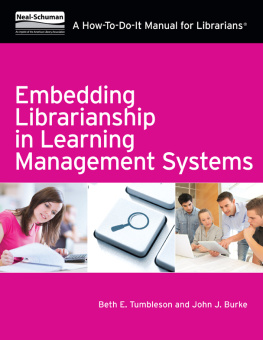
First Printing, 2012
The Embedded Librarian: Innovative Strategies for Taking Knowledge Where Its Needed
Copyright 2012 by David Shumaker
All rights reserved. No part of this book may be reproduced in any form or by any electronic or mechanical means, including information storage and retrieval systems, without permission in writing from the publisher, except by a reviewer, who may quote brief passages in a review. Published by Information Today, Inc., 143 Old Marlton Pike, Medford, New Jersey 08055.
Publishers Note: The author and publisher have taken care in the preparation of this book but make no expressed or implied warranty of any kind and assume no responsibility for errors or omissions. No liability is assumed for incidental or consequential damages in connection with or arising out of the use of the information or programs contained herein.
Many of the designations used by manufacturers and sellers to distinguish their products are claimed as trademarks. Where those designations appear in this book and Information Today, Inc. was aware of a trademark claim, the designations have been printed with initial capital letters.
Library of Congress Cataloging-in-Publication Data
Shumaker, David, 1950
The embedded librarian : innovative strategies for taking knowledge where its needed / David Shumaker.
p. cm.
Includes bibliographical references and index.
ISBN 978-1-57387-452-6
1. Reference services (Libraries). 2. Libraries and institutions. 3. Librarians--Professional relationships. 4. Librarians--Effect of technological innovations on. 5. Teams in the workplace. I. Title.
Z711.S38 2012
025.52--dc23
2012017662
Printed and bound in the United States of America
Editor-in-Chief and Publisher: John B. Bryans
VP Graphics and Production: M. Heide Dengler
Project Editor: Marydee Ojala
Cover Designer: Danielle Nicotra
www.infotoday.com
The research that forms the foundation of this book was supported in part by a grant from the Special Libraries Association. The Special Libraries Association does not necessarily support any of the findings or conclusions presented in the book.
For
Suzannah Alice
This book has been written in less than a year, but the idea for it has been germinating for much longer. Among the many people who have guided, taught, influenced, and encouraged me along the way are, in chronological order:
My colleagues in Information Services at the MITRE Corporation, whose amazing professionalism first showed me the potential of embedded librarianship.
Dr. Martha Hale, former dean of the School of Library and Information Science at the Catholic University of America, who gave me a chance to become a full-time faculty member and encouraged me to pursue a research theme that interested me.
Laura Tyler, who proposed a research project on embedded librarianship and co-authored the first Embedded Library Services paper.
Mary Talley, my co-investigator for the Special Libraries Association (SLA) Models of Embedded Librarianship research grant, whose insight, high standards, and inexhaustible energy were essential to the projects successful outcome.
Judy Siess, who planted the idea of writing a book on embedded librarianship in a conversation at the 2009 SLA Conference and whose Searcher article captures the essence of the model.
Marydee Ojala, editor of this work, who has encouraged and guided me through the proposal and writing process. Marydee has perfected the art of being demanding and supportive at the same time.
And above all, my long-suffering family, especially my wife, Donnafriend and advisor, partner and collaborator.
www.embeddedlibrarian.com
Want to know more? Want to join the conversation? The Embedded Librarian blog, at www.embeddedlibrarian.com, features posts by the author on all matters related to embedded librarianship. New research, interesting updates, and musings on successes and challenges are all part of the mixits the only blog dedicated to embedded librarianship, covering all aspects of this important trend.
Disclaimer
Neither the publisher nor the author make any claim as to the results that may be obtained through the use of this blog or of any of the internet resources it references or links to. Neither publisher nor author will be held liable for any results, or lack thereof, obtained by the use of this blog or any of its links; for any third-party charges; or for any hardware, software, or other problems that may occur as the result of using it. This blog is subject to change or discontinuation without notice at the discretion of the publisher and author.
Imagine a librarian accompanying you throughout the course of your day.
You drive to work, and the librarian is in the car with you, telling you the latest news and helping you avoid traffic jams. You leave your office to get lunch and the librarian walks down the street with you, describing the specials at your favorite restaurants. You go home and sit down to eat, and the librarian is there at the table with you, telling you how the stock market performed that day.
Sound far-fetched or strange? It shouldnt. Librarians historically have been gateways to information, and today we carry pocket-sized and paper-sized librarians around with us wherever we go. We call them different namessmartphones, tablets, netbooks, and so onbut we use them to access information, just as we would a librarian.
With so much information available at the touch of a telephone or computer screen, librarians must identify and embrace new roles to provide value to their organizations and customers. One path that holds promise is to partner with groups of information usersbe they college students working on a class project, scientists conducting drug trials in a laboratory, attorneys researching a difficult court case, or architects designing a new hometo help them gain a competitive advantage. Librarians who follow this path participate in information communities and share responsibility for their success or failure. They develop relationships with team members and identify information sources, programs, and channels that will enhance the teams performance.
This approach, known as embedded librarianship, isnt newit has its roots in the health care field of the 1960s, when librarians began to join doctors and nurses as they visited hospital patients and discussed their status and treatment. What is new is that research has identified the characteristics of successful embedded librarians and illuminated the practices and principles that enable these librarians to exceed their colleagues expectations and add value to their work.
This research has been led by Dave Shumaker, who has spent the past 3-plus years studying embedded librarian programs to determine the criteria that define them, the indicators of their success, and their methods of operation and evaluation. With financial help through a grant from the Special Libraries Association, Dave has traveled to several organizations with embedded programs and conducted interviews and focus groups with librarians and their clients. By analyzing the information he obtained and comparing embedded programs that have thrived over time with those that havent, Dave has developed insights into the nature of embedded librarianship and discerned how it can best serve the interests of organizations and librarians alike.










